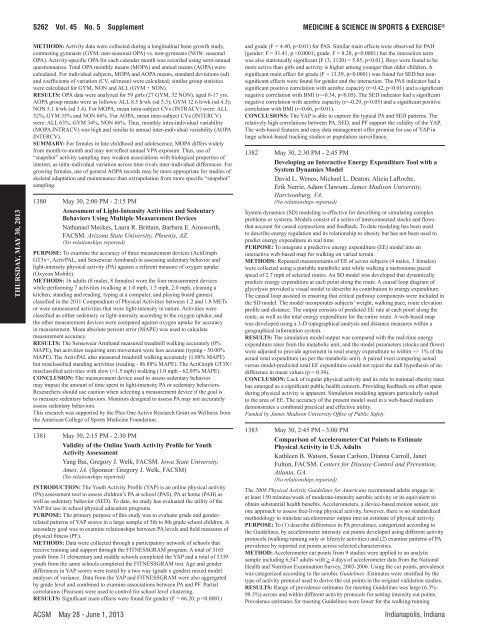Thursday-Abstracts
Thursday-Abstracts
Thursday-Abstracts
Create successful ePaper yourself
Turn your PDF publications into a flip-book with our unique Google optimized e-Paper software.
<strong>Thursday</strong>, May 30, 2013<br />
S262 Vol. 45 No. 5 Supplement<br />
METhOds: Activity data were collected during a longitudinal bone growth study,<br />
contrasting gymnasts (GYM: non-seasonal OPA) vs. non-gymnasts (NON: seasonal<br />
OPA). Activity-specific OPA for each calendar month was recorded using semi-annual<br />
questionnaires. Total OPA monthly means (MOPA) and annual means (AOPA) were<br />
calculated. For individual subjects, MOPA and AOPA means, standard deviations (sd)<br />
and coefficients of variation (CV, sd/mean) were calculated; similar group statistics<br />
were calculated for GYM, NON and ALL (GYM + NON).<br />
rEsuLTs: OPA data were analyzed for 59 girls (27 GYM, 32 NON), aged 8-17 yrs.<br />
AOPA group means were as follows: ALL 8.5 h/wk (sd 5.3); GYM 12.6 h/wk (sd 4.3);<br />
NON 5.1 h/wk (sd 3.4). For MOPA, mean intra-subject CVs (INTRACV) were: ALL<br />
52%, GYM 35% and NON 66%. For AOPA, mean inter-subject CVs (INTERCV)<br />
were: ALL 63%, GYM 34%, NON 66%. Thus, monthly intra-individual variability<br />
(MOPA INTRACV) was high and similar to annual inter-individual variability (AOPA<br />
INTERCV).<br />
suMMary: For females in late childhood and adolescence, MOPA differs widely<br />
from month-to-month and may not reflect annual VPA exposure. Thus, use of<br />
“snapshot” activity sampling may weaken associations with biological properties of<br />
interest, as intra-individual variation across time rivals inter-individual differences. For<br />
growing females, use of general AOPA records may be more appropriate for studies of<br />
skeletal adaptation and maintenance than extrapolation from more specific “snapshot”<br />
sampling.<br />
1380 May 30, 2:00 PM - 2:15 PM<br />
assessment of Light-Intensity activities and sedentary<br />
Behaviors using Multiple Measurement devices<br />
Nathanael Meckes, Laura R. Brittain, Barbara E. Ainsworth,<br />
FACSM. Arizona State University, Phoenix, AZ.<br />
(No relationships reported)<br />
PurPOsE: To examine the accuracy of three measurement devices (ActiGraph<br />
GT3x+, ActivPAL, and Sensewear Armband) in assessing sedentary behavior and<br />
light-intensity physical activity (PA) against a referent measure of oxygen uptake<br />
(Oxycon Mobile).<br />
METhOds: 16 adults (8 males, 8 females) wore the four measurement devices<br />
while performing 7 activities (walking at 1.0 mph, 1.5 mph, 2.0 mph, cleaning a<br />
kitchen, standing and reading, typing at a computer, and playing board games)<br />
classified in the 2011 Compendium of Physical Activities between 1.2 and 1.8 METs<br />
or were unmeasured activities that were light-intensity in nature. Activities were<br />
classified as either sedentary or light-intensity according to the oxygen uptake, and<br />
the other measurement devices were compared against oxygen uptake for accuracy<br />
in measurement. Mean absolute percent error (MAPE) was used to calculate<br />
measurement accuracy.<br />
rEsuLTs: The Sensewear Armband measured treadmill walking accurately (0%<br />
MAPE), but activities requiring arm movement were less accurate (typing - 50.00%<br />
MAPE). The ActivPAL also measured treadmill walking accurately (1.88% MAPE)<br />
but misclassified standing activities (reading - 86.88% MAPE). The ActiGraph GT3X+<br />
misclassified activities with slow (


